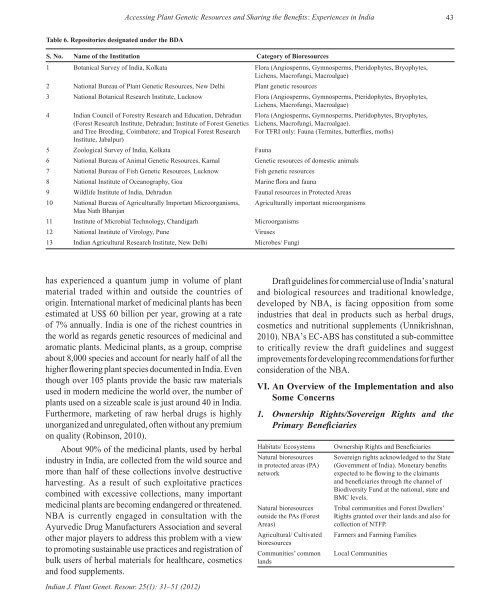indian society of plant genetic resources - Bioversity International
indian society of plant genetic resources - Bioversity International
indian society of plant genetic resources - Bioversity International
You also want an ePaper? Increase the reach of your titles
YUMPU automatically turns print PDFs into web optimized ePapers that Google loves.
Table 6. Repositories designated under the BDA<br />
Indian J. Plant Genet. Resour. 25(1): 31–51 (2012)<br />
Accessing Plant Genetic Resources and Sharing the Benefi ts: Experiences in India 43<br />
S. No. Name <strong>of</strong> the Institution Category <strong>of</strong> Bio<strong>resources</strong><br />
1 Botanical Survey <strong>of</strong> India, Kolkata Flora (Angiosperms, Gymnosperms, Pteridophytes, Bryophytes,<br />
Lichens, Macr<strong>of</strong>ungi, Macroalgae)<br />
2 National Bureau <strong>of</strong> Plant Genetic Resources, New Delhi Plant <strong>genetic</strong> <strong>resources</strong><br />
3 National Botanical Research Institute, Lucknow Flora (Angiosperms, Gymnosperms, Pteridophytes, Bryophytes,<br />
Lichens, Macr<strong>of</strong>ungi, Macroalgae)<br />
4 Indian Council <strong>of</strong> Forestry Research and Education, Dehradun Flora (Angiosperms, Gymnosperms, Pteridophytes, Bryophytes,<br />
(Forest Research Institute, Dehradun; Institute <strong>of</strong> Forest Genetics Lichens, Macr<strong>of</strong>ungi, Macroalgae).<br />
and Tree Breeding, Coimbatore; and Tropical Forest Research<br />
Institute, Jabalpur)<br />
For TFRI only: Fauna (Termites, butterfl ies, moths)<br />
5 Zoological Survey <strong>of</strong> India, Kolkata Fauna<br />
6 National Bureau <strong>of</strong> Animal Genetic Resources, Karnal Genetic <strong>resources</strong> <strong>of</strong> domestic animals<br />
7 National Bureau <strong>of</strong> Fish Genetic Resources, Lucknow Fish <strong>genetic</strong> <strong>resources</strong><br />
8 National Institute <strong>of</strong> Oceanography, Goa Marine fl ora and fauna<br />
9 Wildlife Institute <strong>of</strong> India, Dehradun Faunal <strong>resources</strong> in Protected Areas<br />
10 National Bureau <strong>of</strong> Agriculturally Important Microorganisms,<br />
Mau Nath Bhanjan<br />
Agriculturally important microorganisms<br />
11 Institute <strong>of</strong> Microbial Technology, Chandigarh Microorganisms<br />
12 National Institute <strong>of</strong> Virology, Pune Viruses<br />
13 Indian Agricultural Research Institute, New Delhi Microbes/ Fungi<br />
has experienced a quantum jump in volume <strong>of</strong> <strong>plant</strong><br />
material traded within and outside the countries <strong>of</strong><br />
origin. <strong>International</strong> market <strong>of</strong> medicinal <strong>plant</strong>s has been<br />
estimated at US$ 60 billion per year, growing at a rate<br />
<strong>of</strong> 7% annually. India is one <strong>of</strong> the richest countries in<br />
the world as regards <strong>genetic</strong> <strong>resources</strong> <strong>of</strong> medicinal and<br />
aromatic <strong>plant</strong>s. Medicinal <strong>plant</strong>s, as a group, comprise<br />
about 8,000 species and account for nearly half <strong>of</strong> all the<br />
higher fl owering <strong>plant</strong> species documented in India. Even<br />
though over 105 <strong>plant</strong>s provide the basic raw materials<br />
used in modern medicine the world over, the number <strong>of</strong><br />
<strong>plant</strong>s used on a sizeable scale is just around 40 in India.<br />
Furthermore, marketing <strong>of</strong> raw herbal drugs is highly<br />
unorganized and unregulated, <strong>of</strong>ten without any premium<br />
on quality (Robinson, 2010).<br />
About 90% <strong>of</strong> the medicinal <strong>plant</strong>s, used by herbal<br />
industry in India, are collected from the wild source and<br />
more than half <strong>of</strong> these collections involve destructive<br />
harvesting. As a result <strong>of</strong> such exploitative practices<br />
combined with excessive collections, many important<br />
medicinal <strong>plant</strong>s are becoming endangered or threatened.<br />
NBA is currently engaged in consultation with the<br />
Ayurvedic Drug Manufacturers Association and several<br />
other major players to address this problem with a view<br />
to promoting sustainable use practices and registration <strong>of</strong><br />
bulk users <strong>of</strong> herbal materials for healthcare, cosmetics<br />
and food supplements.<br />
Draft guidelines for commercial use <strong>of</strong> India’s natural<br />
and biological <strong>resources</strong> and traditional knowledge,<br />
developed by NBA, is facing opposition from some<br />
industries that deal in products such as herbal drugs,<br />
cosmetics and nutritional supplements (Unnikrishnan,<br />
2010). NBA’s EC-ABS has constituted a sub-committee<br />
to critically review the draft guidelines and suggest<br />
improvements for developing recommendations for further<br />
consideration <strong>of</strong> the NBA.<br />
VI. An Overview <strong>of</strong> the Implementation and also<br />
Some Concerns<br />
1. Ownership Rights/Sovereign Rights and the<br />
Primary Benefi ciaries<br />
Habitats/ Ecosystems Ownership Rights and Benefi ciaries<br />
Natural bio<strong>resources</strong><br />
in protected areas (PA)<br />
network<br />
Natural bio<strong>resources</strong><br />
outside the PAs (Forest<br />
Areas)<br />
Agricultural/ Cultivated<br />
bio<strong>resources</strong><br />
Communities’ common<br />
lands<br />
Sovereign rights acknowledged to the State<br />
(Government <strong>of</strong> India). Monetary benefi ts<br />
expected to be fl owing to the claimants<br />
and benefi ciaries through the channel <strong>of</strong><br />
Biodiversity Fund at the national, state and<br />
BMC levels.<br />
Tribal communities and Forest Dwellers’<br />
Rights granted over their lands and also for<br />
collection <strong>of</strong> NTFP.<br />
Farmers and Farming Families<br />
Local Communities

















